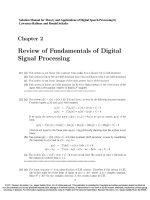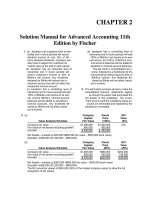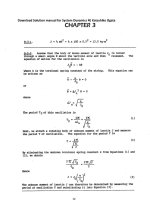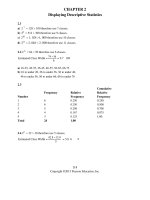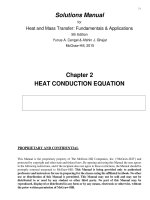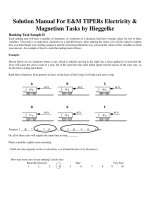Link download solution manual for the mind and heart of the negotiator 5th edition by leigh thompson
Bạn đang xem bản rút gọn của tài liệu. Xem và tải ngay bản đầy đủ của tài liệu tại đây (659.33 KB, 10 trang )
Solution Manual for The Mind and
Heart of the Negotiator 5th edition by
Leigh Thompson
CHAPTER 2
Preparation: What to Do Before Negotiation
OVERVIEW
This chapter is best discussed after students have prepared for and completed their first negotiation of the
course (I suggest a simple, distributive negotiation in a multiweek course). Much class/lecture time
should be spent on the concepts of the BATNA and reservation price. If the instructor is using a group or
team-based approach, student groups can engage in a 15-minute discussion of the factors that were critical for preparation. The instructor can compile a master list of each group’s ideas. This list can be compared with Exhibit 2-4 at the end of the chapter. As several biases are identified in this chapter, the instructor can point to instances of these biases occurring in the actual negotiations that students completed.
For a homework assignment, students can be asked to use the preparation tips in preparing for a real,
out-of-class negotiation.
LECTURE OUTLINE
I.
THE FIXED-PIE PERCEPTION
A. Most negotiators view negotiation as a fixed-pie (fixed-sum) enterprise, in that
they believe whatever is good for one person must be bad for the counterparty.
B. People who have fixed-pie perceptions usually take one of three suboptimal approaches
when preparing for negotiation:
1. Resign themselves to capitulating to the counterparty (soft bargaining)
2. Prepare for attack (hard bargaining)
3. Compromise in an attempt to reach midpoint between opposing desires
(often regarded to be a win-win negotiation, but in fact, it is not)
Copyright ©2012 Pearson Education, Inc. publishing as Prentice Hall
Preparation: What to Do Before Negotiation
CHAPTER 2
2-2
The Fixed-Pie Perception
• Most negotiators usually take one of three
suboptimal approaches when preparing for
negotiation:
• Resignation to capitulating to the other side
(soft bargaining)
• Preparation for attack (hard bargaining)
• Compromise (often regarded to be a winwin negotiation, but in fact, it is not)
Instructor’s Manual with Overheads to accompany
The Mind and Heart of the Negotiator 5/e (Thompson)
Copyright ©20012Pearson Education,
Inc. publishing as Prentice Hall
C. Common assumption is that concessions are necessary by one or both parties to
reach agreement
II.THE MIXED-MOTIVE DECISION-MAKING ENTERPRISE
A. Effective preparation for a negotiation encompasses three general abilities:
1. Self-assessment
2. Assessment of the counterparty
3. Assessment of the situation
III.
SELF-ASSESSMENT
A. What do I want?: Target/aspiration
1. Underaspiring negotiator (winner’s curse)
2. Overaspiring or positional negotiator
3. Grass-is-greener negotiator (reactive devaluation)
B. What is my alternative to reaching agreement in this situation?
1. Best Alternative to a Negotiated Agreement (BATNA)
2. BATNAs and reality
3. Your BATNA is time-sensitive
4. Do not let the counterparty manipulate your BATNA
C. Determine your reservation point (Exhibit 2-1)
1. Step 1: Brainstorm your alternatives
2. Step 2: Evaluate each alternative
3. Step 3: Attempt to improve your BATNA
4. Step 4: Determine your reservation price
D.
E.
F.
G.
H.
Be aware of focal points
Beware of sunk costs
Do not confuse your target point with your reservation point
Identify the issues in the negotiation
Identify the alternatives for each issue
Copyright ©2012 Pearson Education, Inc. publishing as Prentice Hall
9
Preparation: What to Do Before Negotiation 10
I. Identify equivalent packages of offers
1. Packages should all be of equivalent value or attractiveness (also see Appendix 1)
2. Premature concessions
3. Identifying packages of offers does not make you appear to be a positional negotiator
J. Assess your risk propensity
1. Risk aversion
2. Reference points define what people consider gains or losses
3. Three sources of risk in negotiation
a) Strategic risk
b) BATNA risk
c) Contractual risk
K. Endowment effects
1. Reference points
L. Am I going to live to regret this?
1. Counterfactual thinking
M. Violations of the sure thing principle
N. Do I have an appropriate level of confidence?
1. Overconfidence effect
CHAPTER 2
2-3
CHAPTER 2
Preparation: Self-Assessment (I)
Preparation: Self-Assessment (II)
• What do I want (target or aspiration)?
• What is my alternative to reaching agreement in this
situation (BATNA)?
• Determine your reservation point
• Be aware of focal points
• Beware of sunk costs
• Do not confuse your target point with your reservation
point
Instructor’s Manual with Overheads to accompany
The Mind and Heart of the Negotiator 5/e (Thompson)
•
•
•
•
•
•
•
•
Identify the issues in the negotiation
Identify the alternatives for each issue
Identify equivalent packages of offers
Assess your risk propensity
Endowment effects
Am I going to live to regret this?
Violations of the sure thing principle
Do I have an appropriate level of confidence?
Instructor’s Manual with Overheads to accompany
The Mind and Heart of the Negotiator 5/e (Thompson)
Copyright ©20012Pearson Education,
Inc. publishing as Prentice Hall
CHAPTER 2
2-5
Developing a Reservation Point
Step 1: Brainstorm Your Alternatives. Imagine that you want to sell your house. Your target point—$275,000. What will you do in the event that you do
not get an offer of $275,000? Consider as many alternatives as possible.
Step 2: Evaluate Each Alternative. Order the various alternatives in terms of their relative attractiveness, or value. If an alternative has an uncertain
outcome, such as reducing the list price, you should determine the probability that a buyer will make an offer at that price. Suppose that you reduce
the list price to $265,000. Based on research, you assess the probability of an offer to be 60%. The best alternative should be selected to represent
your BATNA.
Step 3: Attempt to Improve Your BATNA. In this case, you might contact a rental company and develop your rental options, or you may make some
improvements that have high return on investment (e.g., new paint). Of course, your most attractive BATNA is to have an offer in hand on y our
house.
Step 4: Determine Your Reservation Price. The least amount of money you would accept for your home at the present time. You assess the probability of
an offer of $250,000 or higher to be 95%. You think there is a 5% chance that you will not get such offer and will rent it. The probabilities always sum
to exactly 100%. We have considered all possible events occurring. No alternative is left to chance. You can assess your expected probabilities of
selling your house:
Reduce the price of your home to $265,000
Psale = 60%
Reduce the price of your home to $250,000
Rent the house
Psale = 35%
Prent = 5%
An overall value for each of these “risky” alternatives is assessed by multiplying the value by its probability:
Value of reducing price to $265,000 = $265,000 x 0.6 = $159,000
Value of reducing price to $250,000 = $265,000 x 0.35 = $87,500
Value of renting the house = $100,000 x 0.05 = $5,000
Add all the values of the alternatives to arrive at an overall evaluation:
= 0.6($265,000) + 0.35($250,000) + 0.05($100,000) = $159,000 + $87,500+ $5,000 = $251,500
Instructor’s Manual with Overheads to accompany
The Mind and Heart of the Negotiator 5/e (Thompson)
2-4
Copyright ©20012Pearson Education,
Inc. publishing as Prentice Hall
Copyright ©2012 Pearson Education, Inc. publishing as Prentice Hall
Copyright ©20012Pearson Education,
Inc. publishing as Prentice Hall
Preparation: What to Do Before Negotiation
IV.
11
SIZING UP THE OTHER PARTY
A. Who are the other parties?
1. Hidden table
B. Are the parties monolithic?
C. Counterparties’ interests and position
D. Counterparties’ BATNAs
CHAPTER 2
2-6
Preparation: Assessing the Other Party
•
•
•
•
Who are the other parties?
Are the parties monolithic?
Counterparties’ interests and position
Other negotiators’ BATNAs
Instructor’s Manual with Overheads to accompany
The Mind and Heart of the Negotiator 5/e (Thompson)
V.
Copyright ©20012Pearson Education,
Inc. publishing as Prentice Hall
SITUATION ASSESSMENT
A. Is the negotiation one-shot, long-term, or repetitive? (Exhibit 2-2)
B. Do the negotiations involve scarce resources, ideologies, or both?
1. Consensus conflict
2. Scarce resource competition
C.
D.
E.
F.
G.
H.
I.
Is the negotiation one of necessity or opportunity?
Is the negotiation a transaction or dispute situation?
Are linkage effects present?
Is agreement required?
Is it legal to negotiate? (Exhibit 2-2)
Is ratification required?
Are there time constraints or other time-related costs?
1. Time pressure and deadlines (Exhibit 2-3)
2. Time-related costs
3. Time horizon
J.
K.
L.
M.
N.
O.
P.
Are contracts official or unofficial?
Where do the negotiations take place?
Are negotiations public or private?
Is third-party intervention a possibility?
What conventions guide the process of negotiation (such as who makes the first offer)?
Do negotiations involve more than one offer?
Do negotiators communicate explicitly or tacitly?
Copyright ©2012 Pearson Education, Inc. publishing as Prentice Hall
Preparation: What to Do Before Negotiation
12
Q. Is a power differential a factor between parties?
R. Is precedent important?
CHAPTER 2
2-7
Preparation: Assessing the Situation (I)
• Is the negotiation one-shot, long-term, or repetitive?
• Do the negotiations involve scarce resources,
ideologies, or both?
• Is the negotiation one of necessity or opportunity?
• Is the negotiation an exchange or dispute situation?
• Are there linkage effects?
• Is agreement required?
• Is it legal to negotiate?
• Is ratification required?
• Are there time constraints or other time-related costs?
Instructor’s Manual with Overheads to accompany
The Mind and Heart of the Negotiator 5/e (Thompson)
VI.
Copyright ©20012Pearson Education,
Inc. publishing as Prentice Hall
CHAPTER 2
2-8
Preparation: Assessing the Situation (II)
•
•
•
•
•
•
•
•
•
Are contracts official or unofficial?
Where do the negotiations take place?
Are negotiations public or private?
Is third-party intervention a possibility?
What conventions guide the process of negotiation
(such as who makes the first offer)?
Do negotiations involve more than one offer?
Do negotiators communicate explicitly or tacitly?
Is there a power differential between parties?
Is precedent important?
Instructor’s Manual with Overheads to accompany
The Mind and Heart of the Negotiator 5/e (Thompson)
Copyright ©20012Pearson Education,
Inc. publishing as Prentice Hall
CONCLUSION
A. Effective preparation places the negotiator at a strategic advantage at the
bargaining table
B. Three general areas of preparation—self, counterparty, context, or situation
C. Summary of preparation (Exhibit 2-4) should be used before negotiation
KEY TERMS
BATNA Acronym for a negotiator’s Best Alternative To a Negotiated Agreement.
consensus conflict Conflict that occurs when one person’s opinions, ideas, or beliefs are incompatible
with those of another.
contractual risk A situation in which settlement outcomes are determined with uncertainty at the time of
settlement.
counterfactual thinking The act of thinking about how things might have turned out differently.
fixed-pie perception The belief that the counterparty’s interests are directly and completely opposed to
one’s own.
focal point Salient number, figure, or value in a negotiation that appears to be valid but is actually
arbitrary and/or has no basis in fact.
hidden table The negotiations that take place behind the scene between a principal and his or her
constituents.
linkage effects A phenomenon that refers to the fact that some negotiations will affect other negotiations;
i.e., resolutions in one situation will have implications for a future situation.
monolithic party A member of a group that acts as a single unit; i.e., there is no divergence within the
group.
Mixed-motive enterprise A negotiation involving both cooperation and competition.
Copyright ©2012 Pearson Education, Inc. publishing as Prentice Hall
Preparation: What to Do Before Negotiation
13
overconfidence effect Refers to unwarranted levels of confidence in people’s judgment of their abilities,
the likelihood of positive events, and underestimates the likelihood of negative events.
party A participant in negotiation. Parties can be individuals, groups, organizations, communities, or
nations.
positional negotiator A person who determines a set of terms desired in a negotiation, presents those
terms, and refuses to budge on any dimension of any issue.
ratification Approval of a contract by a body or group not necessarily present at the negotiation table.
reactive devaluation The tendency for people to devalue an option previously considered to be more
attractive, merely as a consequence of it being offered by the counterparty.
reference point What a person considers to be a gain or loss.
reservation point The point at which a negotiator is indifferent between reaching a settlement and
walking away from the bargaining table.
risk aversion Preference for a sure thing rather than a gamble that has an equal or greater expected value.
scarce resource competition Conflict or competition that exists when people perceive one another as
desiring the same limited resources.
strategic risk The relative risk levels of the tactics that negotiators use at the bargaining table.
sunk costs Money invested that cannot be recovered.
sure thing principle A principle that states that if alternative x is preferred to y, in the condition that
some event, a, occurs, and if x is also preferred to y in the condition that some event, a, does not occur,
then x should be preferred to y, even when it is not known whether a will occur.
target or target point The ideal or upper limit of what a negotiator expects to get out of a negotiation.
Also called the aspiration or aspiration point.
time horizon The amount of time between the negotiation and the consequences, or realization, of
negotiated agreements.
winner’s curse A situation in which a negotiator makes an offer or requests something that is
immediately accepted by the opponent.
SUGGESTED EXERCISES AND OTHER MATERIALS
1. EXERCISE: The Biopharm-Seltek Negotiation
by Leonard Greenhalgh
Biopharm-Seltek is a distributive negotiation over the sale of a manufacturing facility that produces
genetically-engineered compounds. Negotiators are given information about the costs of their
alternatives, but have to determine aspirations, reservation prices, and opening offers themselves.
There are no teaching notes; however, the teaching notes associated with Coffee Contract (see
suggested cases for Chapter 3) can easily be adapted for this exercise. Preparation: 10 min.
Negotiation: 20 min. Available from Creative Consensus, Inc., P.O. Box 5054, Hanover, NH 03755.
Phone/fax: (603) 643-0331.
Copyright ©2012 Pearson Education, Inc. publishing as Prentice Hall
Preparation: What to Do Before Negotiation 14
2. EXERCISE: Coffee Contract
by Tony Simons and Thomas Tripp
Coffee Contract is a distributive exercise. It concerns the contract for coffee at the Cornell Hotel
School. The exercise provides a good context for teaching fundamental negotiation concepts like
bargaining zone, reservation prices, and BATNAs, as well as distributive negotiation tactics, openings, concession making, and threats. Creative students may build in some integrative elements, and
even if the students fail to find these creative ideas, the instructor can use them to introduce integrative negotiations. Preparation: 15 min. Negotiation: 30 min. Available from the Dispute Resolution
Research Center at the Kellogg School of Management, Northwestern University, 2001 Sheridan
Road, Evanston, IL 60208. Phone: (847) 491-8068; e-mail:
3. EXERCISE:
by Leigh Thompson and Leaf Van Boven
Commodities
Brokers
This is a set of three negotiations between two brokers. It is a multiple-time-period, two-party
integrative negotiation between two brokers trading four commodities, in which there is risk involved.
Participants are randomly assigned to the role of Broker Jones or Broker Smith in the trading of
various quantities and grades of wheat, rice, copper, and crude oil. This is an excellent negotiation
exercise for illustrating the impact of risk and uncertainty on behavior and performance over time.
Preparation: 15 min. Negotiation: 30 min. Available from the Dispute Resolution Research Center
at the Kellogg School of Management, Northwestern University, 2001 Sheridan Road, Evanston, IL
60208. Phone: (847) 491-8068; e-mail:
4. EXERCISE: Energetics meets Generex
by W. Trexler Proffitt, Jr.
This is a two-party distributive negotiation based on a real California wind energy farm transaction. It
is good for illustrating biases including anchoring and availability. There is the option to provide an
outside offer during the negotiation that illustrates the power of BATNA. Preparation: 10 min.
Negotiation: 30 min. Available from the Dispute Resolution Research Center at the Kellogg School
of Management, Northwestern University, 2001 Sheridan Road, Evanston, IL 60208. Phone: (847)
491-8068; e-mail:
5. EXERCISE: Les Florets
by Stephen B. Goldberg
A simplified version of Texoil (see below) set in France. Preparation: 30 min. Negotiation: 45-60
min. Available from the Dispute Resolution Research Center at the Kellogg School of Management,
Northwestern University, 2001 Sheridan Road, Evanston, IL 60208. Phone: (847) 491-8068; e-mail:
6. EXERCISE: Texoil
by Stephen B. Goldberg
This is a qualitative negotiation over the sale of some property. The case has no overlapping bargaining zone unless the parties uncover some of each other’s interests. It is a very good case for teaching
about interests, what information should and should not be shared, and creativity in negotiations.
Preparation: 30 min. Negotiation: 60 min. Available from the Dispute Resolution Research Center
at the Kellogg School of Management, Northwestern University, 2001 Sheridan Road, Evanston, IL
60208. Phone: (847) 491-8068; e-mail:
Copyright ©2012 Pearson Education, Inc. publishing as Prentice Hall
Preparation: What to Do Before Negotiation
15
MULTIPLE-CHOICE QUESTIONS
1. The winner’s curse occurs when
A. a negotiator sets his/her aspirations too high
B. a negotiator makes an offer that is immediately accepted
C. the counterparty demonstrates retaliative behavior
D. no one can be trusted
2. A type of negotiation behavior known as reactive devaluation is demonstrated by
A. the grass-is-greener negotiator
B. a positional negotiator
C. an overaspiring negotiator
D. an underaspiring negotiator
3. BATNA (Best Alternative to a Negotiated Agreement) determines the point at which a negotiator is
prepared to
A. make larger concessions
B. keep options open
C. walk away from the negotiation table
D. identify counterparty’s alternatives
4. One strategy for improving one’s BATNA is to
A. discuss it with the counterparty
B. follow the “falling in love” rule
C. replace it with aspiration point
D. change it as a result of the progress of the negotiation
5. The reservation point is mostly related to the
A. negotiator’s target point
B. negotiator’s BATNA
C. bargaining zone (ZOPA)
D. negotiator’s opening offer
6. The three sources of risk in negotiation include
A. tactical risk, strategic risk, overconfidence risk
B. failure risk, BATNA risk, information-sharing risk
C. contractual risk, overconfidence risk, failure risk
D. strategic risk, BATNA risk, contractual risk
7. The endowment effect is
A. the difference between what sellers demand and what buyers are willing to pay
B. a tendency for people to value an object more once they own it
C. the value we associate with a certain object or outcome
D. saving money instead of purchasing goods
8. A dispute occurs when
A. parties have to resort to their BATNAs
B. parties fail to exchange resources
C. a claim is made by one party and rejected by the other party
D. we turn down favors and rewards from others
9. Most commonly, third-party intervention takes the form of
Copyright ©2012 Pearson Education, Inc. publishing as Prentice Hall
Preparation: What to Do Before Negotiation
A.
B.
C.
D.
16
power differential
pie-slicing
partnership
mediation or arbitration
10. Which of the following statements are not true when it comes to BATNAs?
A. They are dynamic and constantly changing
B. It is generally wise to reveal them
C. They are determined by the negotiator’s available options
D. They are a good anchor point for the negotiator
Answer key: 1.B; 2.A; 3.C; 4.B; 5.B; 6.D; 7.B; 8.C; 9.D; 10.B.
DISCUSSION QUESTIONS
1. What is the fixed-pie perception, and how does it affect a person’s preparation for negotiation?
2. What are some of the problems that arise in the determination of one’s target or aspiration point in a
negotiation?
3. What is the difference between a target point and reservation point, and why is it important not to
confuse the two?
4. Why should negotiators break down the issues in a negotiation into multiple issues, rather than
engage in a single-issue negotiation?
5. Why is it advisable to assess the self, the counterparty, and any negotiation situation before
commencing negotiations? What are some of the questions a negotiator needs to address when
assessing the negotiation situation?
Suggested answers:
1. The fixed-pie perception means that whatever is good for one person must ipso facto be bad for the
other party. Negotiators who have this perception usually adopt one of three stances: resign themselves to capitulating to the other side, prepare for a battle of wills, or mutual compromise in an
attempt to reach a midpoint between opposing desires.
2. Identifying a target or aspiration may cause three major problems: setting target or aspirations too low
and opening the negotiation by requesting something that is immediately granted; setting the target
point too high and refusing to make concessions; not knowing what one really wants—only that one
wants what the counterparty is not giving and does not want what the counterparty is offering.
Copyright ©2012 Pearson Education, Inc. publishing as Prentice Hall
Preparation: What to Do Before Negotiation
17
3. Target point relates to an ideal situation, but the reservation point relates to what represents as one’s
BATNA. Using one’s target point as a reservation point can result in the following fatal flaws:
agreeing to a settlement that is worse than what the negotiator could do or walking away from a
potentially profitable deal.
4. In most negotiation situations, more than one issue is at stake but they may remain “hidden” unless
negotiators unbundle them. By doing so, negotiators can add value to negotiations, formalize the
issues and alternatives by creating a matrix, and determine a variety of different combinations of the
issues that all achieve his or her target point.
5. The negotiator who has identified a BATNA and set a reservation price and a target point, knows
when to walk away, and how much is reasonable to concede. The negotiator who has researched the
counterparty’s BATNA and interests is less likely to be tricked or confused. Some of the questions
prior to commencing negotiations are: What do I want?; What are the issues in the negotiation?; What
issues are relevant to the other party?; Is agreement required?
Copyright ©2012 Pearson Education, Inc. publishing as Prentice Hall

